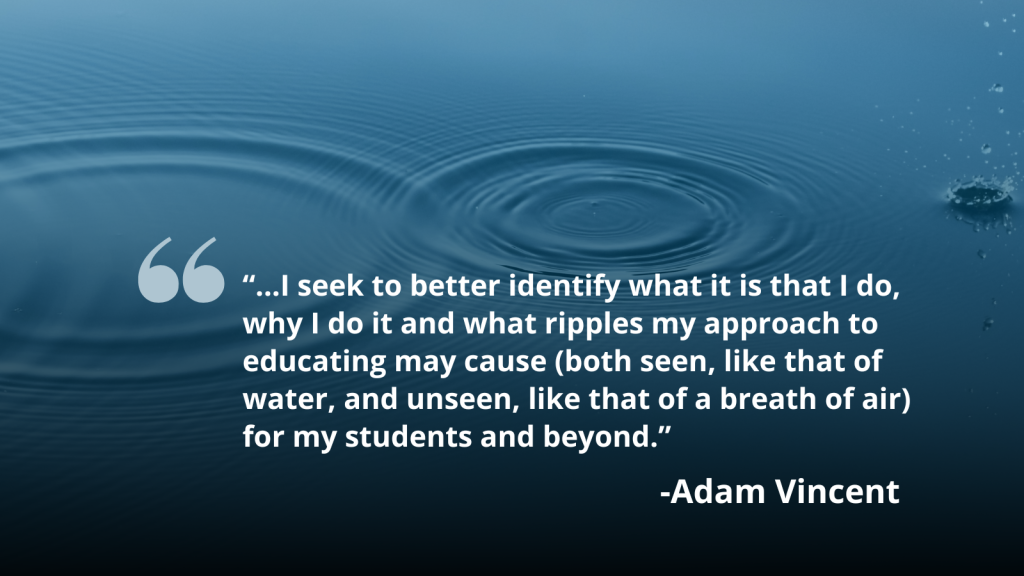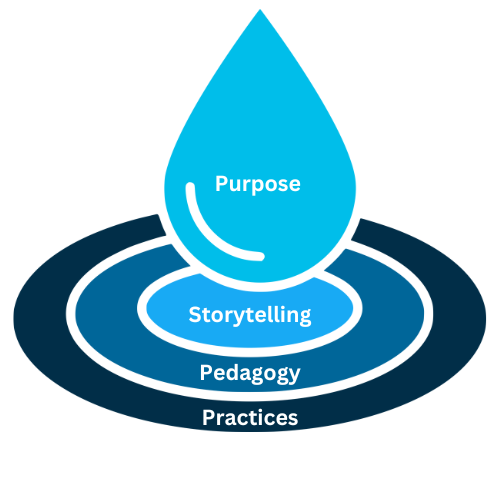Introduction

A ripple effect: a situation in which one event or action produces effects which spread and produce further effects:
The front cover is an image of rain falling in a body of water, with several ripple effects. The reason this image was chosen was because the circles of impact all connect. When an object (such as rain or a stone) disrupts a still body of water, the water moves in ripples across the entire water. A similar ripple effect also occurs in education, among many other fields. These ripples can be big or small – positive or negative. What ends up happening when multiple ripple effects occur – each ripple flows effortlessly into the other. The ripples incorporate into one another create a harmonious blending. With each ripple, you’ll notice momentum builds and can have far-reaching effects. As OER creators, our purpose is to create a ripple effect in our classrooms – beginning with a resource. Just by reading this, you have already chosen to be a catalyst for change, to push yourself to respond to problems in education with equitable solutions, and embrace the complexity and messiness of the process with courage, honesty, and humility.
Learning Objectives
By the end of this section, you will:
- Understand the purpose of the guide;
- Learn about the guide’s structure;
- See the big picture with the ripple effects.
Introduction
Making Ripples: A Guidebook to Challenge Status Quo in OER Creation offers readers a short resource to expand their understanding of inequities in the educational systems through breaking down the work into smaller pieces with opportunities to reflect, identify strategies for action, and locate resources and community members to connect with. The purpose of this guide is to explore strategies for you as OER creators to incorporate equitable practices into your workflows.
It is not enough for educators to acknowledge Diversity, Equity, and Inclusion (often shortened to the acronym DEI or EDI) as a priority – action must follow. As an organization, Rebus is dedicated to building a new, collaborative model for open resource creation in partnership with the OER community. Infused in this model are our core values around collaboration, community, equity, care, and respect. We believe this focus is critical to creating & implementing valuable resources, and can have impacts beyond a single resource, individual, classroom, or institution. With OER, we have the opportunity to challenge the status quo and build a new status quo that is more malleable and flexible. We hope you will join us in building this future!
This guide was written for different audiences, because while the roles we play in our institution may be different, the underlying goal is the same: to educate. Whether you’re a librarian helping faculty pick out texts, an instructor teaching classes, an administrator supporting classrooms & pedagogy, or a student entering a classroom – your goal is to teach and learn.
Making Ripples centers the importance of storytelling and how storytelling can support your journey into developing OER with diversity, equity, and inclusion at the core. This guide has been structured in five parts, with each part containing opportunities to both reflect and take action:

- Purpose of OER Creation: This section emphasizes the importance of collaboration and intentionally centering students while discussing the purpose of creating OER.
- Storytelling in Education: What stories we tell – and how we tell them – matters. In this section, you’ll learn about ethical storytelling and recognize the impact that storytelling has on teaching and learning.
- Equity-minded Pedagogy: After considering how we tell stories, we invite you to reflect on your pedagogical beliefs and practices – and align them with equitable practices to have a positive impact on student learning.
- Practices as Community Service: This section focuses on the importance of lifelong learning, collaboration with community partners, and recognizing how open pedagogy and practices can be integrated into social justice.
- Beyond OER: In this section, you’re asked to deeply reflect on education’s role in society and consider ways in which you can take teaching and learning well beyond traditional educational institutions, creating ripple effects to enact positive change in the world.
While it includes strategies to keeping equity at the forefront of your OER creation process, this guide also encourages you to:
- Reflect on your role in education to transform your pedagogical practices by incorporating equitable methods and interactions into teaching and learning
- Connect and collaborate in and beyond your institutional setting in ethical ways to build equitable relationships and knowledge exchange
- Emphasize and practice reciprocity in teaching and learning by seeking every opportunity as an educator to contribute back to communities
- Embrace the complexity and messiness of the process with courage, honesty, and humility
Diversity, Equity, and Inclusion in Open Education
Because genuine, intentional, and impactful equity work begins at the individual level, it is our hope that the learning opportunities in this resource will set off ripple effects to enact as much positive change inside as well as outside of the academy. It is impossible to extricate the work we do with students in classrooms, libraries, campuses, etc. with the world outside it. Every decision made outside of education impacts education, and vice versa. Skills not taught in classrooms, leads to a lack of specific skills in the world. For example, how we have predominantly taught history courses in both Canada and the United States have often excluded the voices, the stories, and the painful truths of these countries. Fast forward to generations of citizens being taught eurocentric, exclusionary narratives around history, and we have seen the devastating impacts of that – from low civic engagement to hateful legislation being passed. It is crucial we as educators think about these connections often and discuss them with our students. It is through these open and honest conversations that we are able to learn from one another. And when we learn together from one another, we can have much farther-reaching effects than us doing it alone.And when we learn together from one another, we can have much farther-reaching effects than us doing it alone.
Throughout this guide, there will be opportunities for you to pause and reflect on your role in education and your current practices. You’ll also find resources from members of the open community so you can connect and collaborate with community members who are doing this work. A big facet of open education is not reinventing the wheel, so as you read this, remember you are not alone – lean on the open community for support, guidance, and sharing of ideas.
To further inspire your own educational equity journey, you can watch a Tedx talk by Nicole West Burns on Building Critical Consciousness for Educational Equity below.
Before you begin the video, reflect on the following:
- What do the terms equality and equity mean?
- What are your responsibilities to your students?
As you watch the video, pay attention for:
- Why is thinking about student experiences in schools important?
- What do you learn about the mainstream public education system?
After viewing the video, reflect on:
- What vision do you have for the educational system and society?
- What is your active commitment to positive change going to look like?
References:
YouTube. (2020, February 12). Building critical consciousness for educational equity | Nicole West-Burns, Ph.d. | tedxoshawaed. YouTube. Retrieved October 7, 2022, from https://www.youtube.com/watch?v=evndCfQ92s4&ab_channel=TEDxTalks
Media Attributions
- Ripples in Education. © Lins Nylund adapted by Kaitlin Schilling is licensed under a CC BY (Attribution) license
- Introduction Ripple Effect Graphic © Sulthonul Arif adapted by Kaitlin Schilling is licensed under a CC BY (Attribution) license

